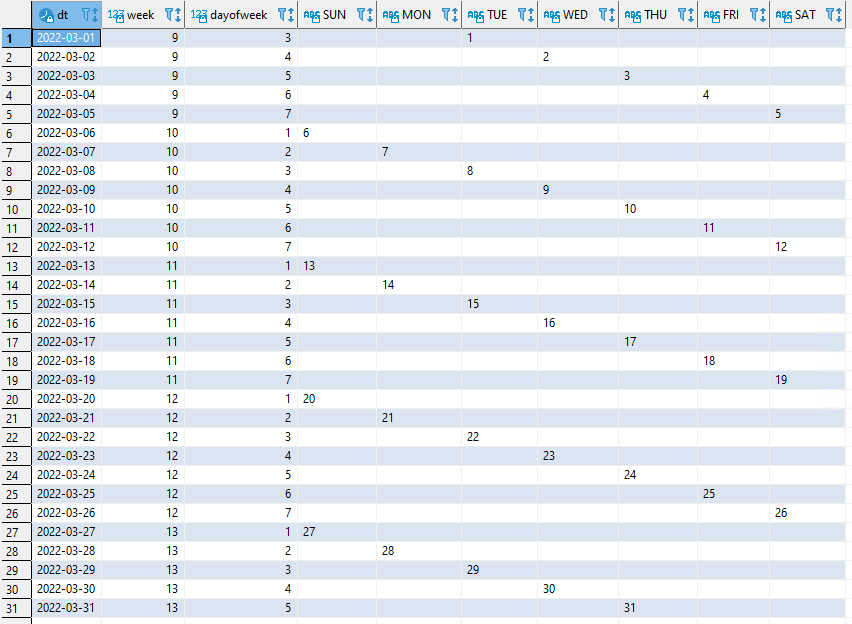曾經閑得無聊用 SQL (MySQL & Oracle) 製作過月曆。分享一下這個小作品吧。效果圖如下:

也許第一眼很難想像怎樣才做到吧。但其實相當簡單的,用 MySQL 寫大概二十行左右便能寫好。
with recursive seq (dt) as (
select last_day(curdate() - interval 1 month) + interval 1 day as dt
union all
select seq.dt + interval 1 day
from seq
where seq.dt < last_day(curdate())
)
select
max(case when dayofweek(dt) = 1 then dayofmonth(dt) else '' end) as SUN,
max(case when dayofweek(dt) = 2 then dayofmonth(dt) else '' end) as MON,
max(case when dayofweek(dt) = 3 then dayofmonth(dt) else '' end) as TUE,
max(case when dayofweek(dt) = 4 then dayofmonth(dt) else '' end) as WED,
max(case when dayofweek(dt) = 5 then dayofmonth(dt) else '' end) as THU,
max(case when dayofweek(dt) = 6 then dayofmonth(dt) else '' end) as FRI,
max(case when dayofweek(dt) = 7 then dayofmonth(dt) else '' end) as SAT
from seq
group by week(seq.dt, 0)
;
也用 Oracle 寫過,不過弄丟了。但其實根據這思路,不同 DBMS 都可以製作出來的。另外,我寫 SQL 通常優先跟從 ANSI Standard, 以便萬一需要時,較易在其他 DB 重現。
以上的 Query 基本上分為兩步:
1. 建立數列 1, 2, 3, 4, 5 ...
因為這是 Recursive CTE 的經典用法,同時也是 ANSI Standard, 所以便採用了。不過要留意你所使用的 DBMS 版本是否支援,例如 MySQL 要 ≥ 8.0, Oracle 要 ≥11gR2.
如果不支援,那改用其他方法吧。例如 Oracle 可以用 connect by, PostgreSQL 可以用 generate_series()。
只要你得能到數列,那就能輕鬆轉換為 date series 了。日子 + 1, 2, 3, 4, 5 ... 日,就變成了 date series 了。
with recursive seq (dt) as (
select last_day(curdate() - interval 1 month) + interval 1 day as dt
union all
select seq.dt + interval '1' day
from seq
where seq.dt < last_day(curdate())
)
select *
from seq
;
2. 行列轉換
用 CASE 建立新 columns 星期 日, 一, 二 ... 六。用 function dayofweek(dt) 獲知是星期幾,是不是和 column 名稱相符合。是的話 value 則是日子 dayofmonth(dt),不是的話就 NULL (而我為了美觀,所以用 empty string '')
覺得自己可能解釋得不太好呢,那就改一改 Query 再截圖吧。
這是 group by 前的情況:
with recursive seq (dt) as (
select last_day(curdate() - interval 1 month) + interval 1 day as dt
union all
select seq.dt + interval '1' day
from seq
where seq.dt < last_day(curdate())
)
select dt,
week(dt, 0) as `week`,
dayofweek(dt) as `dayofweek`,
case when dayofweek(dt) = 1 then dayofmonth(dt) else '' end as SUN,
case when dayofweek(dt) = 2 then dayofmonth(dt) else '' end as MON,
case when dayofweek(dt) = 3 then dayofmonth(dt) else '' end as TUE,
case when dayofweek(dt) = 4 then dayofmonth(dt) else '' end as WED,
case when dayofweek(dt) = 5 then dayofmonth(dt) else '' end as THU,
case when dayofweek(dt) = 6 then dayofmonth(dt) else '' end as FRI,
case when dayofweek(dt) = 7 then dayofmonth(dt) else '' end as SAT
from seq
;
從上可見 week() 可以得知該日是一年內的第幾個星期(重點我們是需要它「同屬一個星期的日子都會得到相同的數值」這個特性!)
而同一個 week() 裡,最多只有一個星期日,一個星期一,一個星期二……
若我們 group by week() , 那麼如上圖的首5行,都是 week = 9,便會併成一行 (row)。
再選用恰當的 aggregate function, 這裡用的是 max(), 例如 column TUE 經過 max(1, ‘’, ‘’, ‘’, ‘’) ⇒ 1。
最後,就變成想要的模樣啦。

雖然製作一個月曆出來沒有用,但我覺得以上提到的兩點都算是做 SQL report / Data warehousing 的重要技巧。
有興趣的話,你也可以簡單地改進下上面的 SQL,例如將 SQL 弄得簡潔一些,和將當日(執行 SQL 的日子)附以星號 * 標示。